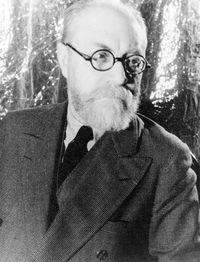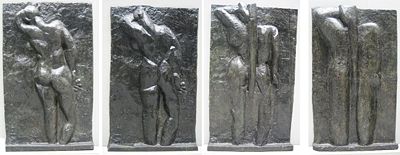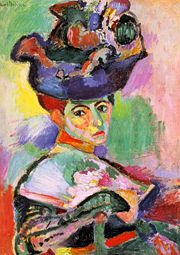Henri Matisse
2008/9 Schools Wikipedia Selection. Related subjects: Artists
| Henri Matisse | |
 Photo of Henri Matisse by Carl Van Vechten, 1933. |
|
| Birth name | Henri Matisse |
| Born | December 31, 1869 Le Cateau-Cambrésis, Nord-Pas-de-Calais |
| Died | November 3, 1954 (aged 84) Nice, France |
| Nationality | French |
| Field | painting, printmaking, sculpture, drawing, collage |
| Movement | Fauvism, Modernism |
| Works | Woman With Hat (Madame Matisse), 1905 |
Henri Matisse ( December 31, 1869 – November 3, 1954) was a French artist, known for his use of colour and his fluid, brilliant and original draughtsmanship. As a draughtsman, printmaker, and sculptor, but principally as a painter, Matisse is one of the best-known artists of the 20th century. Although he was initially labeled as a Fauve (wild beast), by the 1920s, he was increasingly hailed as an upholder of the classical tradition in French painting. His mastery of the expressive language of colour and drawing, displayed in a body of work spanning over a half-century, won him recognition as a leading figure in modern art.
Early life and education
Born Henri-Émile-Benoît Matisse in Le Cateau-Cambrésis, Nord-Pas-de-Calais, France, he grew up in Bohain-en-Vermandois in Northeastern France, where his parents owned a seed business. He was their first son. In 1887 he went to Paris to study law, working as a court administrator in Le Cateau-Cambrésis after gaining his qualification. He first started to paint in 1889, when his mother had brought him art supplies during a period of convalescence following an attack of appendicitis. He discovered "a kind of paradise" as he later described it, and decided to become an artist, deeply disappointing his father. In 1891 he returned to Paris to study art at the Académie Julian and became a student of William-Adolphe Bouguereau and Gustave Moreau. Initially he painted still-lifes and landscapes in the traditional Flemish style, at which he achieved reasonable proficiency. Chardin was one of Matisse's most admired painters; as an art student he made copies of four Chardin paintings in the Louvre. In 1896 he exhibited 5 paintings in the salon of the Société Nationale des Beaux-Arts, and the state bought two of his paintings. In 1897 and 1898, he visited the painter John Peter Russell on the island Belle Île off the coast of Brittany. Russell introduced him to Impressionism and to the work of Van Gogh (who had been a good friend of Russell but was completely unknown at the time). Matisse's style changed completely, and he would later say "Russell was my teacher, and Russell explained colour theory to me."
Influenced by the works of the post-Impressionists Paul Cézanne, Gauguin, Van Gogh and Paul Signac, and also by Japanese art, he made colour a crucial element of his paintings. Many of his paintings from 1899 to 1905 make use of a pointillist technique adopted from Signac. In 1898, he went to London to study the paintings of J. M. W. Turner and then went on a trip to Corsica.
With the model Caroline Joblau, he had a daughter, Marguerite, born in 1894. In 1898 he married Amélie Noellie Parayre; the two raised Marguerite together and had two sons, Jean (born 1899) and Pierre (born 1900). Marguerite often served as a model for Matisse.
Fauvism
His first solo exhibition was in 1904, without much success. His fondness for bright and expressive colour became more pronounced after he moved southwards in 1905 to work with André Derain and spent time on the French Riviera. The paintings of this period are characterized by flat shapes and controlled lines, with expression dominant over detail.
In 1905, Matisse and a group of artists now known as " Fauves" exhibited work together in a room at the Salon d'Automne. Critic Louis Vauxcelles described the work with the phrase " Donatello au milieu des fauves!" (Donatello among the wild beasts), referring to a Renaissance-type sculpture that shared the room with them. His comment was printed on 17 October 1905 in Gil Blas, a daily newspaper, and passed into popular usage. The pictures gained considerable condemnation, such as "A pot of paint has been flung in the face of the public" from the critic Camille Mauclair, but also some favourable attention. The painting that was singled out for attacks was Matisse's Woman with a Hat, which was bought by Gertrude and Leo Stein: this had a very positive effect on Matisse, who was suffering demoralization from the bad reception of his work.
Matisse was recognized as a leader of the group, along with André Derain; the two were friendly rivals, each with his own followers. Other members were Georges Braque, Raoul Dufy and Maurice Vlaminck. The Symbolist painter Gustave Moreau was the movement's inspirational teacher, and he did much for the era; a professor at the École des Beaux-Arts in Paris, he pushed his students to think outside of the lines of formality and to follow their visions.
In 1907 Appolinaire, commenting about Matisse in an article published in La Falange, said, "We are not here in the presence of an extravagant or an extremist undertaking: Matisse's art is eminently reasonable." But Matisse's work of the time also encountered vehement criticism, and it was difficult for him to provide for his family. His controversial 1907 painting Nu bleu was burned in effigy at the Armory Show in Chicago in 1913.
The decline of the Fauvist movement, after 1906, did nothing to affect the rise of Matisse; many of his finest works were created between 1906 and 1917, when he was an active part of the great gathering of artistic talent in Montparnasse, even though he did not quite fit in, with his conservative appearance and strict bourgeois work habits.
Matisse had a long association with the Russian art collector Sergei Shchukin. He created one of his major works La Danse specially for Shchukin as part of a two painting commission, the other painting being Music, 1909. Matisse painted an extra (second) version of La Danse that is in the collection of The Museum of Modern Art in New York City.
Gertrude Stein, Académie Matisse, and the Cone sisters
Around 1904 he met Pablo Picasso, who was 12 years younger than him. The two became life-long friends as well as rivals and are often compared; one key difference between them is that Matisse drew and painted from nature, while Picasso was much more inclined to work from imagination. The subjects painted most frequently by both artists were women and still lifes, with Matisse more likely to place his figures in fully realized interiors. Matisse and Picasso were first brought together at the Paris salon of Gertrude Stein and her companion Alice B. Toklas. During the first decade of the 20th century Americans in Paris Gertrude Stein, her brothers Leo Stein, Michael Stein and Michael's wife Sarah were important collectors and supporters of Matisse's paintings. In addition Gertrude Stein's two American friends from Baltimore Clarabel and Etta Cone became major patrons of Matisse and Picasso, collecting hundreds of their paintings. The Cone collection is now exhibited in the Baltimore Museum of Art.
His friends organized and financed the Académie Matisse in Paris, a private and non-commercial school in which Matisse instructed young artists. It operated from 1911 until 1917. Hans Purrmann and Sarah Stein were amongst several of his most loyal students.
After Paris


In 1917 Matisse relocated to Cimiez on the French Riviera, a suburb of the city of Nice. His work of the decade or so following this relocation shows a relaxation and a softening of his approach. This "return to order" is characteristic of much art of the post-World War I period, and can be compared with the neoclassicism of Picasso and Stravinsky, and the return to traditionalism of Derain. His orientalist odalisque paintings are characteristic of the period; while popular, some contemporary critics found this work shallow and decorative.
After 1930 a new vigor and bolder simplification appear in his work. American art collector Albert C. Barnes convinced him to produce a large mural for the Barnes Foundation, The Dance II, which was completed in 1932. The Foundation owns several dozen other Matisse paintings.
He and his wife of 41 years separated in 1939. In 1941 he was diagnosed with cancer and, following surgery, he started using a wheelchair. Until his death he would be cared for by a Russian woman, Lidia Delektorskaya, formerly one of his models. With the aid of assistants he set about creating cut paper collages, often on a large scale, called gouaches découpés. His Blue Nudes series feature prime examples of this technique he called "painting with scissors"; they demonstrate the ability to bring his eye for colour and geometry to a new medium of utter simplicity, but with playful and delightful power.
In 1947 he published Jazz, a limited-edition book containing prints of colorful paper cut collages, accompanied by his written thoughts. In the 1940s he also worked as a graphic artist and produced black-and-white illustrations for several books.
Matisse, thoroughly unpolitical, was shocked when he heard that his daughter Marguerite, who had been active in the Résistance during the war, was tortured and imprisoned in the Ravensbrück concentration camp.
In 1951 he finished a four-year project of designing the interior, the glass windows and the decorations of the Chapelle du Rosaire in Vence. This project was the result of the close friendship between Matisse and Sister Jacques-Marie. He had hired her as a nurse and model in 1941 before she became a Dominican Nun and they met again in Vence and started the collaboration, a story related in her 1992 book Henri Matisse: La Chapelle de Vence and in the 2003 documentary "A Model for Matisse".
Matisse died of a heart attack at the age of 84 in 1954. He is interred in the cemetery of the Monastère Notre Dame de Cimiez and a Matisse Museum was opened in the area.
Legacy
The first painting of Matisse acquired by a public collection was Still Life with Geraniums (1910), exhibited in the Pinakothek der Moderne. Today, a Matisse painting can fetch as much as US $17 million. In 2002, a Matisse sculpture, Reclining Nude I (Dawn), sold for US $9.2 million, a record for a sculpture by the artist.
Matisse's daughter Marguerite often aided Matisse scholars with insights about his working methods and his works. She died in 1982 while compiling a catalog of her father's work.
Matisse's son, Pierre Matisse, (1900-1989) opened an important modern art gallery in New York City during the 1930s. The Pierre Matisse Gallery which was active from 1931 until 1989 represented and exhibited many European artists and a few Americans and Canadians in New York often for the first time. He exhibited Joan Miró, Marc Chagall, Alberto Giacometti, Jean Dubuffet, André Derain, Yves Tanguy, Le Corbusier, Paul Delvaux, Wilfredo Lam, Jean-Paul Riopelle, Balthus, Leonora Carrington, Zao Wou Ki, Sam Francis, sculptors Theodore Roszak, Raymond Mason and Reg Butler, and several other important artists, including the work of Henri Matisse.
Henri Matisse's grandson, Paul Matisse, is an artist and inventor living in Massachusetts. Matisse's great granddaughter Sophie Matisse is active as an artist in 2008.
Partial list of works
- Woman Reading (1894), Museum of Modern Art, Paris
- Notre-Dame, une fin d'après-midi (1902), Albright-Knox Art Gallery, Buffalo, New York
- The green line (1905)
- The Open Window (1905)
- Woman with a Hat (1905)
- Les toits de Collioure (1905)
- Landscape at Collioure (1905)
- Le bonheur de vivre (1906)
- The Young Sailor II (1906)
- Self-Portrait in a Striped T-shirt (1906)
- Madras Rouge (1907)
- Blue Nude (Souvenir de Biskra) (1907), Baltimore Museum of Art
- The Dessert: Harmony in Red (The Red Room) (1908)
- Bathers with a Turtle (1908), Saint Louis Art Museum, Missouri
- La Danse (1909)
- Still Life with Geraniums (1910)
- L'Atelier Rouge (1911)
- The Conversation (1908–1912)
- Zorah on the Terrace (1912)
- Le Rifain assis (1912)
- Le rideau jaune (the yellow curtain) (1915)
- The Window (1916), Detroit Institute of Arts, Michigan
- La leçon de musique (1917)
- The Painter and His Model (1917)
- Interior A Nice (1920)
- Odalisque with Raised Arms (1923), National Gallery of Art, Washington
- Yellow Odalisque (1926)
- The Dance II (1932), triptych mural (45 ft by 15 ft) in the Barnes Foundation of Philadelphia
- Robe violette et Anémones (1937)
- Woman in a Purple Coat (1937)
- Le Rêve de 1940 (the dream of 1940) (1940)
- La Blouse Roumaine (1940)
- Le Lanceur De Couteaux (1943)
- Annelies, White Tulips and Anemones (1944), Honolulu Academy of Arts
- L'Asie (1946)
- Deux fillettes, fond jaune et rouge (1947)
- Jazz (1947)
- The Plum Blossoms (1948)
- Chapelle du Saint-Marie du Rosaire (1948 - 1951)
- Beasts of the Sea (1950)
- The Sorrows of the King (1952)
- Black Leaf on Green Background (1952)
- La Négresse (1952)
- Blue Nudes (1952)
- The Snail (1953)
- Le Bateau (1954) (This gouache created a minor stir because MOMA had mistakenly displayed it upside-down for 47 days in 1961.)
Books
- Jazz, 1947
- Matisse on Art, collected by Jack D. Flam, 1973. ISBN 0714815187
